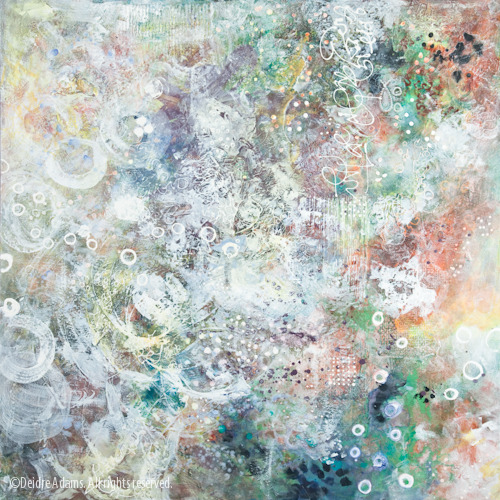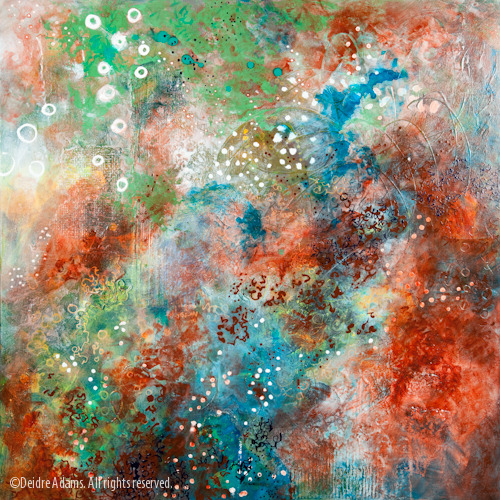 Parable (working title), 36 x 36 inches. Thread, handmade paper, and acrylic paint on panel. ©2010 Deidre Adams.
Parable (working title), 36 x 36 inches. Thread, handmade paper, and acrylic paint on panel. ©2010 Deidre Adams.
I’ve been working more on my paintings in preparation for the thesis show. Although I originally started this series from an idea about the brain and cells and memory and dreams (see A State of Resonance), that’s all kind of fallen by the wayside as I’ve been working more into these paintings. I realized that I’m falling back to my usual way of working, which applies whether I’m working with textiles or painting on panels, or any other medium, and that is a focus on process. I work intuitively, starting with some basic layers of things and responding to them as I go. All of my work is about texture and layering, influenced by the things I’m drawn to visually: crumbling walls, peeling paint, rusty hinges, and marks. There is an inherent aspect of time, as surfaces are changed over time by the environment and by human intervention.
Rereading my earlier words, this seems to be the single most pertinent thing I said in that post:
I’m still working with texture, because after so many years of working with textiles, I’ve developed an inseparable connection with the tactile nature of materials. Besides the visual texture imparted by the lines, shapes, colors and markings in this work, I’m also using thread, string, fragments of handmade paper, and other embedded objects to impart elements of physical texture to the surface. I’m still very interested in creating a sense of depth and layering here, in an attempt to create an illusion that you are moving into the piece.
In the BFA thesis class, we spend a lot of time working on our statements. The thesis statement is distinguished from the artist’s statement in a couple of ways, the most notable of which seems to me to be that it’s a lot longer and therefore full of more pontificating and “artspeak.” In attending past senior thesis shows and trying to read the statements, I’ve found that in most cases they were way too long and my mind would start wandering before I could get through the whole thing. A lot of them sound like they’re just regurgitating a bunch of theory to score points.
In writing mine, I’m trying to be as honest as possible without sounding overly academic and pompous. On the other hand, I do want to make an effort to go along with the system to a certain extent, basically so I can get a good grade. Here’s the part where I’m having difficulty. We are supposed to name a couple of influences, and each named influence must be visible in the work. I mention wabi-sabi, as the idea of finding beauty in the impermanent and the imperfect is very influential, but they also want some actual art movements and/or specific artists named.
Now I have a lot of artists in mind whose work I admire: Robert Rauschenberg, Jasper Johns, Robert Ryman, Eva Hesse, Gordon Matta-Clark, Susan Rothenberg, Wayne Thiebaud, Richard Diebenkorn, plus many more contemporary painters, textile artists, and photographers. But there is not a single one that I looked at and said, “I want to make work like that.” So I’m going about this in a rather backwards way, I suppose. I’m paging through all my Art in America and ARTnews magazines and a bunch of books to find something that looks similar or has a similar intent. Can’t really find anything terribly appropriate. For lack of a better idea right now, I guess I’m going to go with Abstract Expressionism, since the look of my work is somewhat similar to some of the gestural painters, although I think my philosophy of working doesn’t really fit. (Emotional intensity and self-denial? I hardly think so.) I’m open to suggestions.
One other note, specifically on the painting above. I first did this one last semester, but I wasn’t really satisfied with it in its original incarnation. Then, after I got a comment that it looked like an image of a nebula taken from the Hubble telescope, I realized that was pretty far off my intention. Here’s what it looked like before the rework:
Well, that color really was too wild, and even though a certain person is disappointed about it, I like the new version quite a bit better. I’m in charge here, after all!


Deirde,
1st – I LOVE the texture and subtleness you’re getting in this painting!
2nd – I don’t know how it works in academic art, but I say BRAVO to the fact that you never set out to make work that is just like one artist, and frankly cringe to see that you’re feeling like you have to retroactively find something to fit that will give you a good grade. Is it possible to discuss the artists you listed above and you point out what in particular about each artist you find compelling? And then draw parallels to that aspect in their work and your own?
In my own untrained way I’ve been writing about inspirational artists on my blog (you’re on the list of folks to talk about, BTW!) and I’m finding that the more I do this, the more I can narrow in on the thing that really inspires me about the very disparate group of people whose work makes me go “Ahhh!”
I wish you luck with getting through your thesis, and frankly, hope you get through it quickly so you can get back to MAKING!
Candy
Really wonderful rework on that one! The directions your art is taking are amazing. Such a joy to see!
Don’t completely fall into the Thesis, Jen Garner BS! It messes with your mind. Its great to take a step back and look a bit more into your work and why you do what you do but if we have to force a reason, find an artist we resemble just to make some paragraph sound good and “official”, then we may as well copy a bunch of Diebenkorn paintings and write their critique! I mean it’s great to have a little feedback and direction with what you’re trying to say but all in all, aren’t you the one saying it?
You should just turn in your website address as your statement. :o)
Thanks for all the support, everyone. Candy, that would be an honor, your blog is amazing. I don’t know how you find the time to keep up with so many blogs and yet still be able to do your own work. Do you ever sleep? 😉
Heather, such great advice from someone who’s been through the Thesis class already. You’re right, of course, and that’s my stance as well. But for some reason I’m super weird about getting As. At my age, it’s not like anyone’s going to want to see my transcripts. But no matter how much I tell myself it doesn’t matter and why should I even want to play their game, I can’t stop caring about it. A holdover from my conformist, validation-seeking childhood, I suppose!
Hello Deidre:
Ah, influences. I am never reluctant to name mine, but I think too many people in the officialdom of the art world confuse influence with homage. For example, I am hugely influenced by Gian Lorenzo Bernini. However, i challenge anyone who’s ever seen my photography to actually find a picture remotely reminiscent of Bernini.
That’s because my inner state is influenced by him, sort of like when I’m driving through the Great Plains and cranking Led Zeppelin on the CD player — it puts me in the frame of mind I need to be in.
One of the few overt influences on me is Walker Evans — however, I was taken pictures in the Evans mode when I was in my early 20s, before I knew who he was, or had ever seen one of his works. So, am I influenced by Evans, or do I just have a kinship with him?
Now, am i influenced by Deidre Adams, or am I photographing grain elevators and using similar color schemes because I share an artistic sense-of-life with her?
Influences are like the artist’s aesthetic pedigree. But the true originator in art is always kind of a mutt. Only a mongrel can have the wherewithal to be sui generis.
“That’s because my inner state is influenced by him…”
Yes, that’s it exactly. It’s an inner thing, something you carry within while working, but it may not necessarily have an outward visible connection.
“So, am I influenced by Evans, or do I just have a kinship with him?”
Robert, this is such a great flash of insight; that’s how I’ll solve the problem. Instead of saying I’m influenced by any particular person or art movement, I’ll say “my work shares an affinity with such-and-such.” Brilliant!
Thank you.